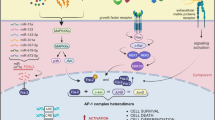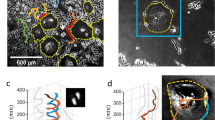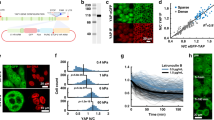Abstract
The AP-1 transcription factor is composed of members of the Fos, Jun and ATF families, and plays a key role in tumor progression. We investigated whether Fos proteins regulate cell motility, and if so, whether this capacity is related to their transactivation potential. Two cell lines with different expression profiles of AP-1 were employed focusing on the Fos-family members c-Fos, Fra-1 and Fra-2. Transactivation motifs are found in c-Fos, but not in Fra-1 or Fra-2. The adenocarcinoma CSML0 cells display a low motility and do not express Fra-1 or Fra-2, and only very little c-Fos. In contrast, the fibroblastoid L929 cells express both Fra-1 and Fra-2, but no c-Fos, and these cells display a high motility. Transfection with Fra-1 or c-Fos, but not with Fra-2, strongly enhanced the motility of CSML0 cells. The effect of Fra-1 required the presence of the N-terminal domain of this protein. Conversely, transfection with a Fos dominant-negative mutant or with anti-sense fra-1 or fra-2, strongly reduced the motility of L929 cells. Changes in cell motility correlated with the morphological appearance and the degree of contact with the substratum. We conclude that Fos proteins have distinct roles in the regulation of cell motility.
This is a preview of subscription content, access via your institution
Access options
Subscribe to this journal
Receive 50 print issues and online access
$259.00 per year
only $5.18 per issue
Buy this article
- Purchase on Springer Link
- Instant access to full article PDF
Prices may be subject to local taxes which are calculated during checkout







Similar content being viewed by others
References
Albrektsen T and Fleckner J . (2001). Mol Pharmacol., 59, 567–575.
Andersen H, Mahmood S, Tkach V, Cohn M, Kustikova O, Grigorian M, Berezin V, Bock E, Lukanidin E and Tulchinsky E . (2002). Oncogene, 21, 4843–4848.
Bergers G, Graninger P, Braselmann S, Wrighton C and Busslinger M . (1995). Mol. Cell. Biol., 15, 3748–3758.
Dunn GA . (1983). Leucocyte Locomotion and Chemotaxis, Keller H, Till GO and Abor A (eds.) Birkhauser Verlag: Basel, pp. 14–33.
DiMilla PA, Stone JA, Quinn JA, Albelda SM and Lauffenburger DA . (1993). J. Cell. Biol., 122, 729–737.
Funk M, Poensgen B, Graulich W, Jerome V and Müller R . (1997). Mol. Cell. Bio., 17, 537–544.
Hai T and Curran T . (1991). Proc. Natl. Acad. Sci. USA, 88, 3720–3724.
Hirai SI, Ryseck RP, Mechta F, Bravo R and Yaniv M . (1989). EMBO J., 8, 1433–1439.
Jain J, McCaffrey PG, Miner Z, Kerppola TK, Lambert JN, Verdine GL, Curran T and Rao A . (1993). Nature, 365, 352–355.
Kassis J, Lauffenburger DA, Turner T and Wells A . (2001). Semin. Cancer Biol., 11, 105–117.
Kataoka K, Fujiwara KT, Noda M and Nishizawa M . (1994). Mol. Cell. Biol., 14, 7581–7591.
Kovary K and Bravo R . (1992). Mol. Cell. Biol., 12, 5051–5023.
Kustikova O, Kramerov D, Grigorian M, Berezin V, Bock E, Lukanidin E and Tulchinsky E . (1998). Mol. Cell. Biol., 18, 7095–7105.
Lauffenburger DA and Lindermann JJ . (1993). Receptors, Models for Binding, Trafficking and Signaling. Oxford University Press: New York, pp. 236–344.
Lee HY, Chaudhary J, Walsh G, Hong W and Kurie J . (1998). Oncogene, 16, 3039–3046.
Lee W, Mitchell P and Tjian R . (1987). Cell, 49, 741–752.
Lepekhin EA, Walmod PS, Berezin A, Berezin V and Bock E . (2000). Methods Mol. Biol., 161, 85–100.
Malliri A, Symons M, Hennigan RF, Hurlstone AFL, Lamb RF, Wheeler T and Ozanne BW . (1998). J. Cell Biol., 143, 1087–1099.
Matsuo K, Owens JM, Tonko M, Elliott C, Chambers TJ and Wagner EF . (2000). Nat. Genet., 24, 184–187.
Mechta F, Lallemand D, Pfarr C and Yaniv M . (1997). Oncogene, 14, 837–847.
Murakami M, Sonobe M, Ui M, Kabuyama Y, Watanabe H, Wada T, Handa H and Iba H . (1997). Oncogene, 14, 2435–2444.
Olive M, Krylov D, Echlin DR, Gardner K, Taparowsky E and Vinson C . (1997). J. Biol. Chem., 272, 18586–18594.
Palecek SP, Loftus JC, Ginsberg MH, Lauffenburger DA and Horwitz AF . (1997). Nature, 385, 537–540.
Senin VM, Ivanov AM, Afanasjeva AV and Buntsevich AM . (1984). Vestn USSR Acad. Med. Sci., 5, 85–91.
Suzuki T, Okuno H, Yoshido T, Endo T, Nishina H and Iba H . (1991). Nucl. Acids Res., 19, 5537–5542.
Tulchinsky E . (2000). Histol. Histopath., 15, 921–928.
Walmod PS, Foley A, Berezin A, Ellerbeck U, Nau H, Bock E and Berezin V . (1998). Cell Motil. Cytoskeleton, 40, 220–237.
Walmod PS, Hartmann-Petersen R, Berezin A, Prag S, Kiselyov VV, Berezin V and Bock E . (2000). Methods Mol. Biol., 161, 59–83.
Wisdom R and Verma IM . (1993). Mol. Cell. Biol., 13, 7429–7438.
Acknowledgements
This work was supported by grants from the Danish Cancer Society, the Danish Medical Research Council, the Danish Cancer Research Foundation, the Danish Natural Science Research Council, The John and Birthe Meyer Foundation and the Lundbeck Foundation.
Author information
Authors and Affiliations
Corresponding author
Rights and permissions
About this article
Cite this article
Tkach, V., Tulchinsky, E., Lukanidin, E. et al. Role of the Fos family members, c-Fos, Fra-1 and Fra-2, in the regulation of cell motility. Oncogene 22, 5045–5054 (2003). https://doi.org/10.1038/sj.onc.1206570
Received:
Revised:
Accepted:
Published:
Issue Date:
DOI: https://doi.org/10.1038/sj.onc.1206570
Keywords
This article is cited by
-
Fra-2/AP-1 regulates melanoma cell metastasis by downregulating Fam212b
Cell Death & Differentiation (2021)
-
All-trans retinoic acid enhances the effect of Fra-1 to inhibit cell proliferation and metabolism in cervical cancer
Biotechnology Letters (2020)
-
MicroRNA-34 suppresses breast cancer invasion and metastasis by directly targeting Fra-1
Oncogene (2013)
-
Insidious role of nitric oxide in migration/invasion of colon cancer cells by upregulating MMP-2/9 via activation of cGMP-PKG-ERK signaling pathways
Clinical & Experimental Metastasis (2012)
-
The effects of timing of fine needle aspiration biopsies on gene expression profiles in breast cancers
BMC Cancer (2008)



